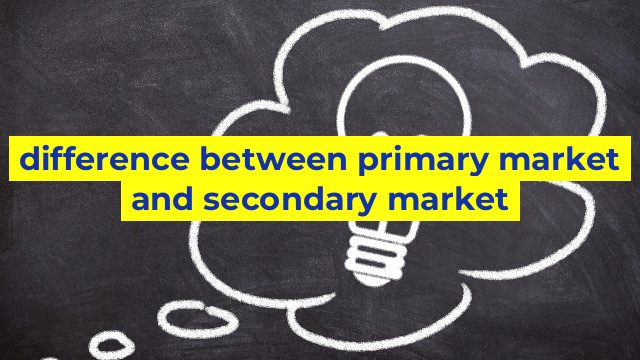Difference between Primary Market and Secondary Market
Introduction
The world of finance is complex and vast, with a multitude of terms that can be difficult to understand. Two of these essential terms are Primary Market and Secondary Market. Although they may sound similar, they have different meanings and functions. In this article, we will explore the differences between the primary market and secondary market.
Primary Market
The primary market is also known as the new issue market. It is a platform where companies raise capital by issuing shares or securities to the public for the very first time. The proceeds raised from these newly issued shares or securities are used by the company to expand its business operations, pay off debts, and invest in research and development. The primary market is operated through IPO (Initial Public Offering) or FPO (Follow-on Public Offering), which is facilitated by investment banks or financial institutions.
Secondary Market
The secondary market, also known as the stock market, is where securities and shares that have already been issued in the primary market are bought and sold. Once a company has raised capital through an IPO or FPO, its shares or securities become available for purchase on the secondary market. The secondary market is a platform where investors can trade these pre-existing securities among themselves, without any involvement from the issuing company.
Differences between Primary Market and Secondary Market
The primary and secondary market may sound similar, but they differ in many ways:
- The primary market is where initial public offerings, or IPOs take place, while the secondary market deals with trading of securities that are already in circulation.
- The primary market is used for raising capital and expanding business, while the secondary market is used for buying and selling securities between investors.
- The primary market is less active, with fewer participants, whereas the secondary market is more active with a large number of buyers and sellers.
- The primary market is more risky as investors buy shares or securities without any previous price or performance history, while the secondary market is less risky as investors can track the previous performance of the security.
- The primary market is managed by investment banks or financial institutions, while the secondary market is regulated by stock exchanges and regulatory bodies.
Conclusion
In conclusion, the primary market and secondary market have different functions, operations, and risks. The primary market is used for the issuance of new securities by companies, while the secondary market is a platform for investors to trade these securities. It is important for investors to understand the difference between the two markets to make informed investment decisions.
Table difference between primary market and secondary market
| Primary Market | Secondary Market |
|---|---|
| The primary market is the financial market where new securities are issued and sold for the first time. | The secondary market is where securities that have already been issued in the primary market are bought and sold amongst investors. |
| The issuers in the primary market are typically companies or governments looking to raise capital. | The buyers and sellers in the secondary market are investors or traders looking to profit from changes in price. |
| In the primary market, the price of securities is determined through an initial public offering (IPO) or private placement, and typically set by underwriters. | In the secondary market, the price of securities is determined by supply and demand, with prices fluctuating on a daily basis. |
| The primary market is considered more risky, as the securities have no market history or data to analyze. | The secondary market is considered less risky, as there is more information available on the securities and their performance in the market. |
| Transactions in the primary market are typically conducted through investment banks, while transactions in the secondary market are conducted through stock exchanges, brokers, and other intermediaries. | The secondary market provides liquidity to investors, enabling them to sell their securities when they need to cash out, and providing opportunities for new investors to enter the market. |


